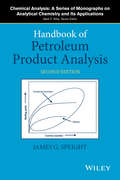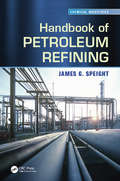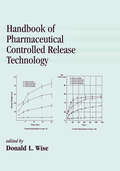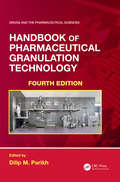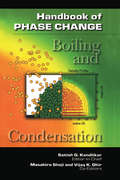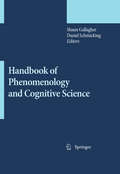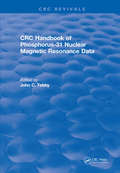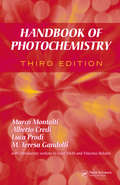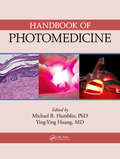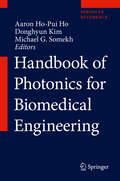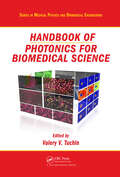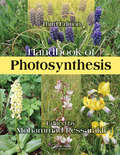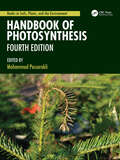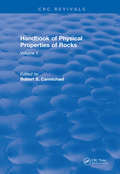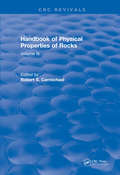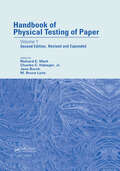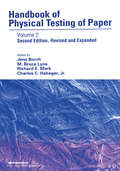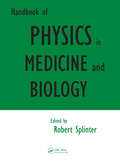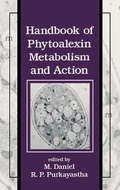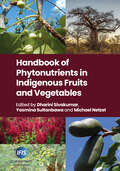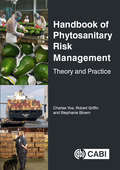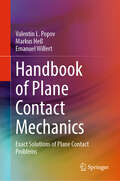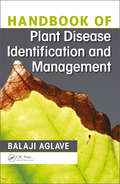- Table View
- List View
Handbook of Petroleum Product Analysis
by James G. SpeightThis book deals with the various aspects of petroleum product analysis and provides a detailed explanation of the necessary standard tests and procedures that are applicable to products in order to help define predictability of behavior. In addition, the application of new methods for determining instability and incompatibility are described. More importantly, the book provides details of the meaning of the various test results and how they might be applied to predict product behavior. It provides a comprehensive single source that describes the application and interpretation of the data of the various test methods for petroleum productsMany of the chapters from the 1st Edition have been rewritten to include the latest developments in the product specifications and testing protocols. Updates on the evolving test methods and new test methods are presented.The book contains information related to four sections: petroleum properties, petroleum refining processes, production of petroleum products, and testing procedures for petroleum and petroleum products. This information is further sub-divided into chapters relating to the properties and specifications petroleum feedstocks and production and properties including: Petroleum, Analytical Methods, Sampling and Measurement of Liquid Petroleum Products, Liquefied Petroleum Gas (including refinery gas), Naphtha and Solvents, Gasoline, Aviation and Marine Fuels, Kerosene, Diesel Fuel, Distillate Heating Oil, Residual Fuel Oil, White Oil, Lubricating Oils (including used lubricating oil), Grease, Wax, Residua and Asphalt, Coke, Carbon Black and Graphite, and Use of the Data
Handbook of Petroleum Refining (Chemical Industries #143)
by James G. SpeightPetroleum refining involves refining crude petroleum as well as producing raw materials for the petrochemical industry. This book covers current refinery processes and process-types that are likely to come on-stream during the next three to five decades. The book includes (1) comparisons of conventional feedstocks with heavy oil, tar sand bitumen, and bio-feedstocks; (2) properties and refinability of the various feedstocks; (3) thermal processes versus hydroprocesses; and (4) the influence of refining on the environment.
Handbook of Pharmaceutical Controlled Release Technology
by Donald L. WiseThe Handbook of Pharmaceutical Controlled Release Technology reviews the design, fabrication, methodology, administration, and classifications of various drug delivery systems, including matrices, and membrane controlled reservoir, bioerodible, and pendant chain systems.Contains cutting-edge research on the controlled delivery of biomolecules!
Handbook of Pharmaceutical Granulation Technology (Drugs and the Pharmaceutical Sciences #4)
by Dilip M. ParikhThis fully revised edition of Handbook of Pharmaceutical Granulation Technology covers the rapid advances in the science of agglomeration, process control, process modelling, scale-up, emerging particle engineering technologies, along with current regulatory changes presented by some of the prominent scientist and subject matter experts around the globe. Learn from more than 50 global subject matter experts who share their years of experience in areas ranging from drug delivery and pharmaceutical technology to advances in nanotechnology. Every pharmaceutical scientist should own a copy of this fourth edition resource. Key Features: Theoretical discussions covering granulation and engineering perspectives. Covers new advances in expert systems, process modelling and bioavailability Chapters on emerging technologies in particle engineering Updated Current research and developments in granulation technologies
Handbook of Phase Change: Boiling and Condensation
by S.G. KandlikarProvides a comprehensive coverage of the basic phenomena. It contains twenty-five chapters which cover different aspects of boiling and condensation. First the specific topic or phenomenon is described, followed by a brief survey of previous work, a phenomenological model based on current understanding, and finally a set of recommended design equa
Handbook of Phenomenology and Cognitive Science
by Shaun Gallagher Daniel SchmickingThe idea that phenomenology, in the European tradition, has something to offer the cognitive sciences is a recent development. Here, leading researchers address topics that lie at the intersection between phenomenological studies and the cognitive sciences.
Handbook of Phosphorus-31 Nuclear Magnetic Resonance Data (CRC Press Revivals)
by John C. TebbyTo fully utilize Nuclear Magnetic Resonance (NMR) spectroscopy, a comprehensive and well-organized compilation of NMR data is necessary. While compilations have been available for other important NMR nuclei, such as carbon and fluorine, no comprehensive collection of data has been prepared for phosphorus-until now. The CRC Handbook of Phosphorus-31 Nuclear Magnetic Resonance Data provides a collection of 31P NMR chemical shifts for nearly 20,000 organic and inorganic phosphorus compounds. Each class of phosphorus compound is discussed. Bond types, stereochemistry (with the exception of metal complexes), media, important coupling constants, and data sources are included. The information is systematically organized according to coordination state, the atoms bound to phosphorus, and their connectivities. A comprehensive series of bar charts is also included to allow structure types to be assigned to chemical shift data. This handbook is an invaluable resource for all scientists working with phosphorus compounds, including chemists, biochemists, medical researchers, and pharmaceutical chemists.
Handbook of Photochemistry
by Marco Montalti Alberto Credi Luca Prodi M. Teresa GandolfiSince the publication of the second edition of this handbook in 1993, the field of photochemical sciences has continued to expand across several disciplines including organic, inorganic, physical, analytical, and biological chemistries, and, most recently, nanosciences. Emphasizing the important role light-induced processes play in all of these fie
Handbook of Photomedicine
by Michael R. Hamblin Ying-Ying HuangProviding the most comprehensive, up-to-date coverage of this exciting biomedical field, Handbook of Photomedicine gathers together a large team of international experts to give you a complete account of the application of light in healthcare and medical science. The book progresses logically from the history and fundamentals of photomedicine to di
Handbook of Photonics for Biomedical Engineering
by Donghyun Kim Aaron Ho-Pui Ho Michael G. SomekhNanophotonics has emerged rapidly into technological mainstream with the advent and maturity of nanotechnology available in photonics and enabled many new exciting applications in the area of biomedical science and engineering that were unimagined even a few years ago with conventional photonic engineering techniques. Handbook of Nanophotonics in Biomedical Engineering is intended to be a reliable resource to a wealth of information on nanophotonics that can inspire readers by detailing emerging and established possibilities of nanophotonics in biomedical science and engineering applications. This comprehensive reference presents not only the basics of nanophotonics but also explores recent experimental and clinical methods used in biomedical and bioengineering research. Each peer-reviewed chapter of this book discusses fundamental aspects and materials/fabrication issues of nanophotonics, as well as applications in interfaces, cell, tissue, animal studies, and clinical engineering. The organization provides quick access to current issues and trends of nanophotonic applications in biomedical engineering. All students and professionals in applied sciences, materials, biomedical engineering, and medical and healthcare industry will find this essential reference book highly useful.
Handbook of Photonics for Biomedical Science (Series in Medical Physics and Biomedical Engineering)
by Valery V. TuchinThe Handbook of Photonics for Biomedical Science analyzes achievements, new trends, and perspectives of photonics in its application to biomedicine. With contributions from world-renowned experts in the field, the handbook describes advanced biophotonics methods and techniques intensively developed in recent years.Addressing the latest problems in
Handbook of Photosynthesis (Books in Soils, Plants, and the Environment)
by Mohammad PessarakliSince the publication of the previous editions of the Handbook of Photosynthesis, many new ideas on photosynthesis have emerged in the past decade that have drawn the attention of experts and researchers on the subject as well as interest from individuals in other disciplines. Updated to include 37 original chapters and making extensive revisions to the chapters that have been retained, 90% of the material in this edition is entirely new. With contributions from over 100 authors from around the globe, this book covers the most recent important research findings. It details all photosynthetic factors and processes under normal and stressful conditions, explores the relationship between photosynthesis and other plant physiological processes, and relates photosynthesis to plant production and crop yields. The third edition also presents an extensive new section on the molecular aspects of photosynthesis, focusing on photosystems, photosynthetic enzymes, and genes. New chapters on photosynthesis in lower and monocellular plants as well as in higher plants are included in this section. The book also addresses growing concerns about excessive levels and high accumulation rates of carbon dioxide due to industrialization. It considers plant species with the most efficient photosynthetic pathways that can help improve the balance of oxygen and carbon dioxide in the atmosphere. Completely overhauled from its bestselling predecessors, the Handbook of Photosynthesis, Third Edition provides a nearly entirely new source on the subject that is both comprehensive and timely. It continues to fill the need for an authoritative and exhaustive resource by assembling a global team of experts to provide thorough coverage of the subject while focusing on finding solutions to relevant contemporary issues related to the field.
Handbook of Photosynthesis (Books in Soils, Plants, and the Environment)
by Mohammad PessarakliThe Fourth Edition of the Handbook of Photosynthesis offers a unique and comprehensive collection of topics in the field of photosynthesis, serving as an invaluable resource in this field. With contributions from 95 scientists and experts from over 20 countries, this volume has been divided into 13 parts, each serving independently to facilitate the understanding of the material.FEATURES Presents comprehensive information on photosynthesis under normal and environmental stress conditions Covers artificial photosynthesis and its future-related issues Contains 25 new chapters and 18 extensively revised and expanded chapters Includes three new sections: Influence of Nanoparticles on Photosynthesis; Protection of Photosynthesis System and Stress Alleviation Strategies by Photosynthates Manipulations and Photosynthesis Efficiency in Plants under Multiple Abiotic and Biotic Stressors; and Artificial Photosynthesis and Its Future Contains numerous tables, figures, illustrations, and case studies to facilitate the comprehension of the material as well as thousands of index words A primary resource in its field, Handbook of Photosynthesis, Fourth Edition, provides a comprehensive resource for researchers, academics, and for university courses, with the information as a valuable source to plan, implement, and evaluate strategies for dealing with photosynthesis issues.
Handbook of Physical Properties of Rocks: Volume II (CRC Press Revivals)
by Robert S. CarmichaelThis three-volume handbook provides reliable, comprehensive data on the properties of rocks, minerals, and other related materials. The format is largely tabular and graphical, designed for ease of use in comparisons and referencing. The chapters are contributed by recognized experts from leading university, industrial, and governmental scientific establishments.
Handbook of Physical Properties of Rocks: Volume III (CRC Press Revivals)
by Robert S. CarmichaelThis three-volume handbook provides reliable, comprehensive data on the properties of rocks, minerals, and other related materials. The format is largely tabular and graphical, designed for ease of use in comparisons and referencing. The chapters are contributed by recognized experts from leading university, industrial, and governmental scientific establishments.
Handbook of Physical Testing of Paper: Volume 1, Second Edition,
by Jens Borch M. Bruce Lyne Richard E. Mark Charles C. Habeger Koji MurakamiContains basic principles and the latest techniques in paper and paperboard testing. Fosters an understanding of theory and mechanical testing parameters to evaluate results and make improvements. Emphasizes new procedures utilizing advanced microscopy equipment.
Handbook of Physical Testing of Paper: Volume 2
by Jens Borch M. Bruce Lyne Richard E. Mark Charles C. HabegerThis handbook focuses on physical paper testing in the laboratory and online. Divided into five parts, it highlights assays for paper interactions with light, moisture, electricity, and heat. Topics expanded upon include laboratory testing procedures; microscopy analysis and paper surface properties; liquid and gas penetration; electrical and thermal interactions; and methods of surface characterization.
Handbook of Physics in Medicine and Biology
by Robert SplinterIn considering ways that physics has helped advance biology and medicine, what typically comes to mind are the various tools used by researchers and clinicians. We think of the optics put to work in microscopes, endoscopes, and lasers; the advanced diagnostics permitted through magnetic, x-ray, and ultrasound imaging; and even the nanotools, that a
Handbook of Phytoalexin Metabolism and Action
by M DanielProvides the latest information on nearly all of the phytoalexins of crop plants studied worldwide over the past 50 years-describing experimental approaches to the research of specific plants and offering detailed explanations on methods of isolation and characterization. Supplies in-depth coverage of cotton, soybean, groundnut, citrus, mustard, grapevine, potato, pepper, sweet potato, yam, sesame, tea, tobacco, pea, pigeon pea, and many more.
Handbook of Phytochemical Constituent Grass, Herbs and Other Economic Plants: Herbal Reference Library (Herbal Reference Library)
by James A. DukeCRC Handbook of Phytochemical Constituents of GRAS Herbs and Other Economic Plants is a unique catalog that includes more than 15,000 phytochemical constituents from over 1,000 higher plant species. This volume covers all of the generally-recognized-as-safe (GRAS) herbs and at least 250 important food and medicinal plants. Each entry features the scientific name, one or more common names, a listing of phytochemical constituents, a single datum or range of quantitative data (wet-weight to dry-weight in parts per million), two-letter abbreviation identifying the plant part, and three-letter abbreviation(s) indicating the source(s) of the data. The extraordinary amount of data compiled into an easy-to-use tabular format makes the CRC Handbook of Phytochemical Constituents of GRAS Herbs and Other Economic Plants a volume useful to all pharmacologists, toxicologists, nutritionists, pharmacognicists, and food scientists.
Handbook of Phytonutrients in Indigenous Fruits and Vegetables
by Rajeev Bhat Michael Rychlik Hosakatte Niranjana Murthy Fozia Homa Víctor M Jiménez Mohammad Akhtaruzzaman Stephen Akinola Saleha Akter Mohammad Khairul Alam Adeyemi Oladapo Aremu Manjeshwar Shrinath Baliga Harish Kumar Bastimal Amina Benabdallah Tania Chacón-Ordóñez N.N.G. Chiranthika Daniel Cozzolino Maral Seidi Damyeh Patricia Esquivel Héctor Estrada-Medina Olaniyi Amos Fawole Mohsina Ferdous Miriam Monserrat Ferrer Selina Fyfe Cyrielle Garcia Nadaraj Govender Prasanna P. Gunathilake Ummai Habiba Chafik Hdider H.A.C.O Hettiarachchi Lee-Hoon Ho Riadh Ilahy Beguvalli Subash Inchara Sheikh Nazrul Islam G. Janarny Eugénie Kayitesi Helyes Lajos Vimbainashe E. Manhivi Florence M. Mashitoa Petunia Mashiane Bárbara Paes Mata Patricia Irene Montañez-Escalante Niranjana Moorthi Isabela Jacob Moro Mack Moyo Siphosanele Mafa Moyo Adaucto Bellarmino Netto Gabi Netzel Dr Michael Netzel Olubukola Motunrayo Odeyemi Abiodun Olusola Omotayo Miriam Ferrer Ortega Karkala Sreedhara Pai Karkala Usha Pai Giriyapura Srikantachar Pavankumar Zoltán Pék Elisa Dos Pereira Adaucto B. Pereira-Netto Anh Dao Phan Charlotte Ralison Vonimatra Razafindrazaka María del Ruenes-Morales Luis Vitor Sacramento Mateus Kawata Salgaço André Gonzaga Santos Horst Joachim Schirra Dr Mohammed Wasim Siddiqui Faith Seke Ambreen Naz Shah Md. Tariqul Shajib Kátia Sivieri Heather E Smyth Sukirtha Srivarathan Thuan-Chew Tan Imen Tlili Annegowda Hardur Venkatappa Juliana Vinholes Márcia Vizzotto Olivia Wright Guggalada Govardhana YadavThe effects of inadequate diets on the population include malnutrition, non-communicable diseases and obesity. 'Hidden hunger', also known as micronutrient deficiencies, leads to various health-related disorders and diseases. Indigenous plants, in the form of indigenous fruits and leafy vegetables are gaining interest as a source of nutrients and bioactive phytochemicals, satisfying both food demand and health needs. Moreover, with the impact of climate change, and the importance of sustainability of food systems, it is essential that we investigate new, forgotten and alternative crops that can thrive in harsh conditions, require low fertilizer input, and are easily harvestable. This book contains chapters on 33 understudied indigenous fruits and vegetables from all around the world, including African nightshade, amaranth, baobab fruit, Indian gooseberry, red bush apple and snake melon. Each chapter provides: An overview of plant botany. An understanding of the phytonutrient constituents and health-promoting properties of bioactive compounds or metabolites. Information on the biological activity of the functional compounds that will improve productivity and increase utilization of indigenous fruits and vegetables to sustain food security. Impacts of postharvest storage, processing, and traditional food preparation methods. Potential for new product development. This is an essential resource for academic researchers and industry professionals in the fields of horticulture, agriculture, crop science, human health and nutrition.
Handbook of Phytosanitary Risk Management: Theory and Practice
by Robert Griffin Stephanie Bloem Dr Charles YoePhytosanitary risk management is essential to the global economy as well as the world's ability to feed itself. This book is about understanding the fundamentals of phytosanitary risk management for trade and non-trade issues, and how to manage those risks in an effective and efficient manner that is consistent with the international regulatory framework. Its purpose is to provide the international phytosanitary community and its principal stakeholders with a strong foundation in risk management concepts and a thorough guide to best practices. Starting with the conceptual background necessary for understanding risk management, this book then covers a risk management model with a detailed description of the structure and processes necessary for best practice risk management in the global economy. This is followed by an in-depth look at the continuum of phytosanitary measures with a laser-like focus on key risk management issues, and the book concludes with a final section devoted to an examination of the most compelling risk management issues of the day. This book is: - A comprehensive exposition of phytosanitary risk management. - Valuable both to the experienced risk manager and to those getting started in the field. - Written by a team of experts with extensive professional phytosanitary work experience and knowledge of plant health. Written for professionals, practitioners and policy makers who work in the international trade of plants and plant products and allied fields, this book provides the global phytosanitary community and its principal stakeholders with a practical guide to best risk management practices.
Handbook of Plane Contact Mechanics: Exact Solutions of Plane Contact Problems
by Valentin L. Popov Markus Heß Emanuel WillertThe book contains a structured collection of complete solutions to all relevant plane contact problems. Classic profiles – such as the cylinder, the wedge, or the rectangular flat punch – are considered under centric and eccentric loading, but also a variety of other technically relevant shapes, such as the flat punch with rounded edges, the wedge with rounded tip, or wavy surfaces. With regard to the load configuration, adhesive and non-adhesive normal contacts, tangential contacts, and rolling contacts are considered. The materials considered are elastic isotropic, transversally isotropic, viscoelastic, and functionally graded media. The solutions given are derived in the simplest way available, and, in addition to the macroscopic relationships between load and contact configuration, include the stress fields in the surface and, where applicable, within the contacting bodies.
Handbook of Plant Disease Identification and Management
by Balaji AglaveHandbook of Plant Disease Identification and Management presents the fundamentals of plant diseases identification based on symptomology and management focusing mainly on integrated pest management approach. It discusses a variety of techniques for the diagnosis of crop disease, losses due to crop diseases, and theories behind disease management. It describes how society is constraining the possibilities for management of crop diseases by changing the environment; biologically controlling crop diseases; and the epidemiologic and genetic concepts of managing host genes. <P><P>This book discusses managing diseases through diverse chemical, biological, and physical methods. It highlights climatic factors affecting crops by creating favorable condition for most of the diseases. This book serves as a complete guide for growers, researchers, and graduate students to understand basics of plant disease identification. It explains the disease cycle for respective crops with favorable conditions promoting disease development. It intends to aid growers in managing diseases and help scientists with future research.
